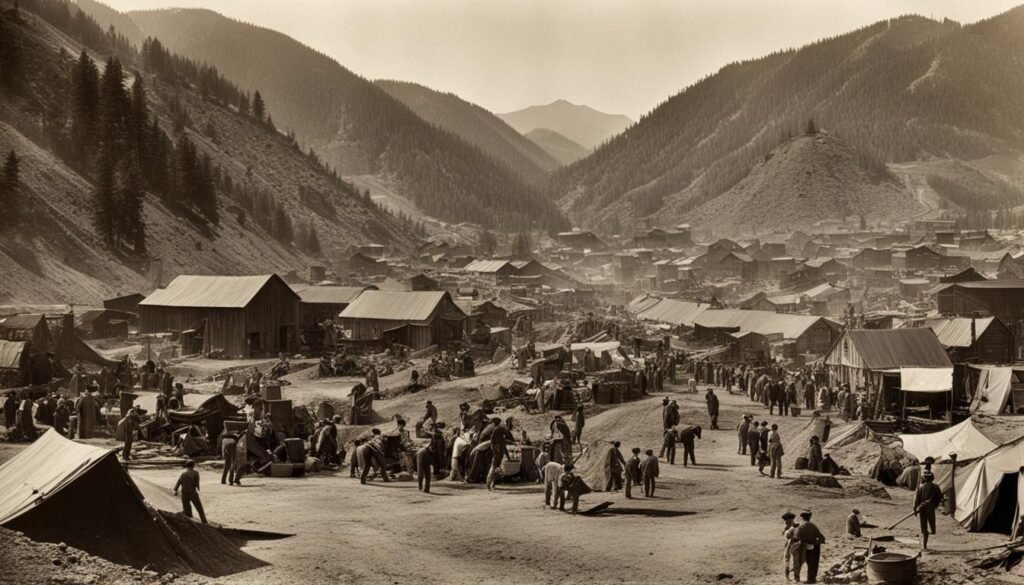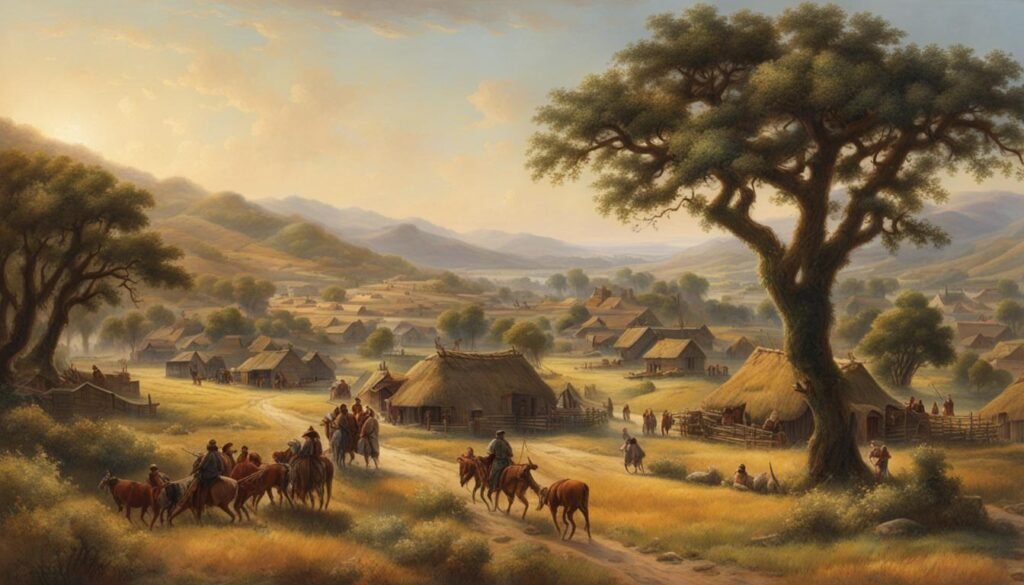Growing up in California, I always had a perception of my home state as a land of freedom and opportunity. However, as I delved deeper into the history books, I uncovered a lesser-known truth: slavery existed in California during the 1850s, despite the state entering the Union as a “free state.” Enslaved Black individuals were brought here to work in the gold mines, and slaveholders were allowed to temporarily bring slaves into the state. This revelation challenged my understanding of California’s past and inspired me to explore the impact of slavery on the state’s economy, racial and social dynamics, and the stories of enslaved individuals who shaped its history.
Key Takeaways:
- Slavery existed in California during the 1850s, despite being a “free state” (Keyword: california slavery)
- Enslaved individuals were brought to California to work in the gold mines (Keyword: slavery and the gold rush in california)
- Slaveholders were allowed to temporarily bring slaves into the state (Keyword: slaveholders in california)
- Understanding the impact of slavery on California’s economy and racial dynamics is crucial (Keywords: impact of slavery on california’s economy, racial and social dynamics in california during slavery)
- The stories of enslaved individuals in California are often overlooked but provide valuable insights into the state’s history (Keyword: enslaved people in california)
California’s Early History of Slavery
California’s early history was characterized by the existence of slavery, despite the state’s designation as a “free state.” The narrative of California as a land of freedom and opportunity during this period is often at odds with historical facts. Enslaved individuals were brought to California to work in the gold mines, a reality that challenges the common perception of the state.
During the Gold Rush, the demand for labor led to the introduction of enslaved individuals who played a crucial role in the mining industry. Moreover, California implemented slave codes, which allowed for temporary enslavement and upheld the institution of slavery. These codes enabled slaveholders to bring their enslaved individuals to the state.
This historical context reveals a more complex and nuanced understanding of California’s early years. The presence of slavery in California sheds light on a hidden aspect of the state’s history and challenges conventional notions of its identity as a beacon of liberty and equality.
The Impact of Slavery on California’s Economy
Slavery had a profound influence on California’s economy during the time it existed. Enslaved individuals played a crucial role in providing labor for various industries, including agriculture and mining. Their contributions were instrumental in shaping the development and prosperity of the state.
In the agricultural sector, California relied heavily on slave labor for large-scale farming operations. Plantation slavery was prevalent, especially in regions where cash crops such as cotton and tobacco were cultivated. The labor-intensive nature of these industries necessitated a significant workforce, with enslaved people being forcibly employed to meet the demands of the market.
Furthermore, enslaved individuals also played a vital role in the mining industry, particularly during the Gold Rush. They provided the labor required to extract gold and other valuable resources from the mines, contributing directly to the economic growth and wealth accumulation in California.
The presence of slavery in California’s economy had far-reaching effects. The utilization of enslaved labor enabled plantation owners and businessmen to amass significant wealth and power. This wealth, in turn, fueled economic growth and allowed for the expansion of industries and infrastructure.
The image above visually represents the impact of slavery on California’s economy during this time period.
It is important to recognize and acknowledge the role that enslaved individuals played in shaping California’s economic landscape. Their labor and forced contributions were integral to the state’s growth and prosperity, despite the immense human suffering endured.
Racial and Social Dynamics in California During Slavery
The presence of slavery in California had a profound impact on the racial and social dynamics of the state. African American slaves played a significant role in shaping California’s diverse population during this time period. Their experiences and contributions are an integral part of California’s African American history.
During the era of slavery, social hierarchies were established, with enslaved individuals at the bottom of the societal ladder. They faced immense challenges and hardships as they navigated a system that treated them as property.
Interaction between different racial groups during slavery was complex. While some individuals recognized the inherent injustice of slavery and fought for its abolition, others upheld the institution and perpetuated racial divisions. These dynamics created a complex web of relationships and attitudes towards slavery and African Americans in California.
Understanding the racial and social dynamics during slavery provides valuable insights into California’s complex past. It allows us to explore the interactions between different racial groups, question the motives and actions of individuals, and gain a deeper understanding of the legacies that persist today.
By examining the racial and social dynamics of California during slavery, we can shed light on the experiences of African American slaves and their contributions to the state’s history. These stories deserve recognition and offer an opportunity for reflection and growth as we strive for a more inclusive and equitable future.

- Racial Diversity: Slavery brought together people from different racial backgrounds, including African Americans, Native Americans, Mexicans, and Europeans, creating a complex social fabric.
- Struggle for Freedom and Equality: African American slaves fought for their rights and freedom, challenging the oppressive system of slavery.
- Legacy and Impact: The racial and social dynamics of slavery continue to shape California’s present-day society, requiring us to confront and address the lasting effects of this dark period in history.
Abolition of Slavery in California
California’s journey towards the abolition of slavery in California was a gradual process. Although the state entered the Union as a “free state” in 1850, slavery still existed. The exact timeline of when slavery officially ended in California requires further research.
However, it is important to acknowledge that the state eventually abolished slavery and took steps towards achieving equality and justice for all.
Uncovering the Lost Stories of California Slavery
The stories of California slavery are often overlooked and neglected in historical narratives. However, a project led by researchers and historians aims to shed light on these “lost” stories. Through extensive research in archives, museums, and historical societies, these researchers are uncovering documents and accounts that offer valuable insights into the experiences of enslaved individuals in California.
By sharing these stories, a more comprehensive understanding of California’s slavery history can emerge. Let’s delve into some captivating California slavery facts and the intriguing history of California slavery that have remained hidden for far too long.
1. Rediscovering Forgotten Narratives
The project’s primary goal is to rediscover narratives that have been ignored or overshadowed by more well-known events and figures. By examining primary sources and firsthand accounts, researchers are piecing together the lives and experiences of enslaved individuals in California.
2. Documenting Personal Testimonies
One aspect of the project involves collecting personal testimonies from descendants of enslaved individuals. These testimonies provide valuable insights into the impact of slavery on individuals and families, offering a unique perspective on California’s history.
3. Analyzing Historical Records
The project also involves meticulous analysis of historical records, including legal documents, newspaper archives, and plantation records. By examining these records, researchers can reconstruct the social and economic dynamics of California slavery, providing a more accurate portrayal of the time period.
4. Challenging Misconceptions
The uncovering of lost stories challenges the prevailing narrative that California was devoid of slavery or had minimal involvement in the institution. It highlights the intricacies and complexities of California’s history, reminding us that the legacy of slavery extends far beyond the Southern states.
5. Building a Comprehensive Narrative
By piecing together these forgotten stories, researchers hope to contribute to a comprehensive and inclusive understanding of California’s past. These narratives add depth and nuance to the history of the state, emphasizing the importance of acknowledging the experiences of enslaved individuals and their contributions to California’s development.
Through the dedicated efforts of researchers and historians, these lost stories of California slavery are finally being brought to light. They offer a valuable opportunity to uncover a more complete history and promote a deeper understanding of the legacy of slavery in California.
The Journey of Black Pioneers to California
The discovery of gold in California during the Gold Rush attracted people from all over the world, including African American individuals seeking new opportunities. For African Americans, California represented a place where, at least legally, slavery did not exist. Many black pioneers made the journey to California in search of a better life and the chance to reinvent themselves. Their stories and experiences contribute to the rich history of African Americans in California.
The California Dream
California, with its promise of gold and prosperity, exerted a powerful pull on African Americans during the mid-19th century. The allure of freedom and the possibility of economic advancement prompted many individuals to leave behind the oppressive conditions of slavery in other parts of the country and make the arduous journey westward.
The Underground Railroad’s Reach
The Underground Railroad, a network of secret routes and safe houses, played a crucial role in aiding the escape of enslaved individuals. While commonly associated with the Eastern United States, the Underground Railroad extended to California as well. This clandestine network provided assistance to freedom seekers, helping them navigate dangerous terrain and avoid capture.
A New Chapter in California
Arriving in California presented African Americans with the opportunity for a fresh start. Many sought employment as gold prospectors, entrepreneurs, or skilled laborers. The absence of legal slavery in California allowed black pioneers to establish businesses, own property, and contribute to the development of local communities.
- The contributions of African American miners during the Gold Rush were significant, yet often overlooked. Many made substantial finds, while others provided crucial support services to the burgeoning mining camps.
- Entrepreneurs like Mary Ellen Pleasant, a notable figure in California’s black history, amassed wealth through savvy business ventures and investments.
- Black churches and other community institutions provided a sense of belonging, as well as support and empowerment for African Americans in the state.
The African American pioneers who made California their home played a vital role in shaping the state’s history and culture. Their resilience, determination, and contributions continue to be celebrated and recognized today.
Challenges Faced by Enslaved Individuals in California
Enslaved individuals in California encountered immense challenges and hardships as victims of the slave trade. The slave trade involved their forced transportation to the state, where they were bought and sold in bustling slave markets. The consequences of slavery inflicted profound impacts on both the individuals themselves and the wider society.
The struggles and experiences of enslaved people in California provide valuable insights into the state’s history and the lasting legacy of slavery. Their stories shed light on the brutal conditions they endured, the persistent denial of their basic human rights, and the systemic oppression they faced.
Consequences of Slavery
The consequences of slavery in California reverberated across the state. Enslaved individuals were denied their freedom, forced to endure backbreaking labor, and subjected to physical and emotional abuse. The inhumane treatment inflicted upon them left lasting scars and perpetuated a system of racial injustice and inequality.
Impact on Families and Communities
The brutal separation of enslaved families caused irreparable damage, as husbands, wives, and children were torn apart and sold to different owners. This resulted in the loss of kinship bonds, cultural heritage, and a sense of identity. Communities of enslaved people struggled to forge connections and find solace in the face of relentless oppression.
Resistance and Resilience
During their enslavement, many individuals in California resisted their captive status through acts of rebellion, escape attempts, and the preservation of their cultural traditions. Their resilience in the face of unimaginable adversity is a testament to the strength of the human spirit and serves as an inspiration for future generations.
Legacy and Lessons Learned
The legacy of slavery in California reverberates to this day, manifested in persistent racial disparities and systemic inequalities. By learning from the challenges faced by enslaved individuals, we can confront the deep-rooted prejudices that continue to permeate society. Acknowledging this painful history is a crucial step towards healing and building a more equitable future.
Voices from California’s Slavery Era
Newspapers and other historical documents from the slavery era in California provide valuable insights into the lives and experiences of enslaved individuals. These primary sources offer glimpses into the harsh realities of slavery and shed light on the resilience and struggles of those who were enslaved. By examining newspapers published during the time of slavery in California, we can gain a deeper understanding of this often overlooked aspect of the state’s history.
Accounts of fugitive slaves provide firsthand narratives of their daring escapes and the challenges they faced in seeking freedom. These stories offer a glimpse into the immense courage and determination exhibited by individuals who risked everything to gain their liberty.
In addition to fugitive accounts, court cases involving enslaved individuals provide a legal perspective on the experiences of enslaved people in California. These court records reveal the injustices and legal battles faced by those seeking emancipation or fighting against harsh treatment. They offer a window into the complexities of the legal system during this time and the struggles that enslaved individuals encountered.
Advertisement for slave auctions found in historical newspapers are a haunting reminder of the commodification of human beings. These documents demonstrate how enslaved individuals were bought and sold as property, further exposing the dehumanizing nature of slavery.
By amplifying the voices and stories found in newspapers and other historical documents, we can gain a more comprehensive understanding of slavery in California. These accounts provide important insights into the lived experiences of enslaved individuals, challenging prevalent narratives and expanding our knowledge of this crucial period in California’s history.
Reparations and the Legacy of Slavery in California
The discussion of reparations for the legacy of slavery and systemic racism is being addressed in California through the establishment of a reparations task force. The California Reparations Task Force is dedicated to studying the historic and systemic racism faced by Black Californians and developing recommendations for reparations. This initiative is part of a broader national conversation on reparations, acknowledging the need to address the lasting effects of slavery and discrimination.
To undertake this crucial work, the California Reparations Task Force will diligently examine the historic and systemic racism that has persisted in the state. By delving into the historical accounts and experiences of enslaved individuals, the task force aims to gain a comprehensive understanding of California’s role in perpetuating racial inequality. Through careful research and analysis, the task force will formulate meaningful recommendations for reparations that address the deep-rooted effects of historic and systemic racism in California.
This significant effort recognizes that the legacy of slavery and ongoing racial disparities continue to impact individuals and communities in California. Reparations can play a vital role in acknowledging past injustices and providing restitution to those who have endured the consequences of historic and systemic racism.

The Path to Reparations in California
The California Reparations Task Force has undertaken extensive research and public hearings to develop recommendations for reparations in the state. The task force acknowledges the need to address the historical injustices inflicted upon enslaved individuals and their descendants. By formulating comprehensive recommendations, the task force aims to provide redress for the enduring impacts of slavery and systemic racism in California.
One of the key recommendations put forth by the task force is the issuance of formal apologies for California’s role in enabling slavery. These apologies serve to acknowledge the state’s past involvement and express remorse for the perpetuation of such a system. Recognizing the profound pain and suffering endured by enslaved individuals and their descendants is an essential step towards healing and reconciliation.
Cash payments to descendants of enslaved individuals are also among the proposed forms of reparations. These payments are designed to provide tangible compensation for the economic and generational disadvantages that resulted from slavery. By acknowledging the financial hardships imposed upon descendants, reparations aim to promote economic empowerment and mobility.
In addition to financial restitution, the task force emphasizes the importance of addressing systemic racism in various sectors. This includes equity initiatives in education, healthcare, housing, employment, and criminal justice. By implementing proactive policies and programs, the intention is to dismantle the systemic barriers that have perpetuated racial disparities and ensure equal opportunities for all Californians.
The task force has carefully considered eligibility criteria to determine who should be eligible for reparations. While specific details are yet to be finalized, the criteria will likely prioritize direct descendants of enslaved individuals, with a focus on establishing genealogical connections. By targeting reparations to those who have historically borne the brunt of slavery’s legacy, the aim is to address the longstanding disparities and provide support where it is most needed.
The final report and recommendations of the California Reparations Task Force will be presented to the state legislature for consideration. This represents a significant step towards fulfilling the commitment to rectify historical injustices and foster a more inclusive and equitable future in California.
Conclusion
The history of slavery in California is a complex and often overlooked aspect of the state’s past. Despite California entering the Union as a “free state,” slavery persisted, with enslaved individuals brought to work in the gold mines and temporary slaveholders allowed in the state. These facts challenge the common perception of California as a land of freedom and opportunity.
The impact of slavery on California’s economy and its racial and social dynamics cannot be ignored. Enslaved individuals contributed to various industries, including agriculture and mining, and plantation slavery existed in regions where large-scale farming took place. African American slaves were part of the state’s diverse population, and their experiences and contributions form an integral part of California’s African American history.
The journey towards abolition in California was a gradual process, and the exact timeline of when slavery officially ended requires further research. However, it is important to recognize that the state eventually abolished slavery and took steps towards achieving equality and justice for all. The ongoing discussion of reparations, led by the California Reparations Task Force, underscores the significance of addressing the lasting effects of slavery and systemic racism in California.
By acknowledging and learning from the history of slavery in California, the state can work towards a more inclusive and equitable future. Recognizing the complexities and impact of slavery, as well as engaging in conversations about reparations, are crucial steps in addressing historical injustices and striving for social and racial justice in the state.
FAQ
What was the history of slavery in California during the 1850s?
Although California entered the Union as a “free state,” slavery still existed in the state during the 1850s. Enslaved Black individuals were brought to California to work in the gold mines, and slaveholders were allowed to bring slaves into the state temporarily.
What was the impact of slavery on California’s economy?
Enslaved individuals provided labor for various industries, including agriculture and mining. Plantation slavery was practiced in California, particularly in regions where large-scale farming took place. The economic contributions of enslaved people played a role in shaping California’s development and prosperity.
How did slavery affect the racial and social dynamics in California?
African American slaves were part of the diverse population during this time period, and their experiences and contributions are an important part of California’s African American history. Understanding the social hierarchies and interactions between different racial groups during slavery provides valuable insights into the state’s complex past.
When did slavery officially end in California?
The exact timeline of when slavery officially ended in California requires further research. However, it is important to acknowledge that the state eventually abolished slavery and took steps towards achieving equality and justice for all.
Are there any efforts to uncover the lost stories of California slavery?
Yes, a project led by researchers and historians aims to shed light on these “lost” stories. By researching archives, museums, and historical societies, they are uncovering valuable insights into the experiences of enslaved individuals in California.
How did the Gold Rush impact African Americans in California?
The discovery of gold in California during the Gold Rush attracted African Americans who were seeking new opportunities. Many black pioneers made the journey to California in search of a better life and the chance to reinvent themselves, contributing to the state’s African American history.
What challenges did enslaved individuals face in California?
Enslaved individuals in California faced numerous challenges and hardships. They were bought and sold in slave markets, and the consequences of slavery left a lasting impact on both individuals and society at large.
Are there any historical records available from the slavery era in California?
Yes, newspapers and other historical documents from the slavery era in California offer glimpses into the lives and experiences of enslaved individuals. Accounts of fugitive slaves, court cases, and advertisements for slave auctions provide valuable information about this often overlooked aspect of California’s history.
Is there any discussion of reparations for the legacy of slavery in California?
Yes, the establishment of a reparations task force in California aims to study the historic and systemic racism faced by Black Californians and develop recommendations for reparations. This initiative acknowledges the need to address the lasting effects of slavery and discrimination.
What recommendations are being considered for reparations in California?
The California Reparations Task Force has considered a range of recommendations, including formal apologies for California’s role in enabling slavery, cash payments to descendants of enslaved individuals, and a focus on addressing systemic racism in various sectors.
What is the conclusion about the history of slavery in California?
The history of slavery in California reveals a complex and often overlooked chapter in the state’s past. The journey towards abolition and the legacy of slavery continue to shape California’s present-day racial and social dynamics. The discussion of reparations highlights the importance of recognizing and addressing the lasting effects of slavery and systemic racism in the state.







